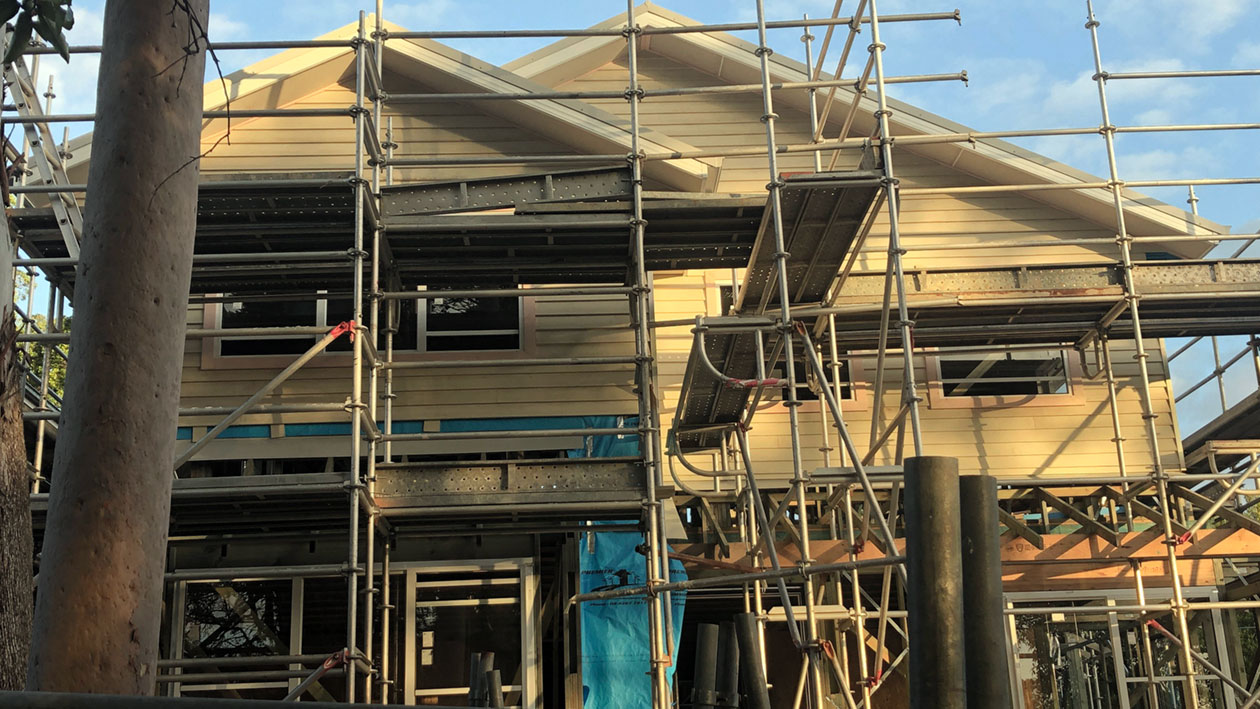A knock-down rebuild is the process of demolishing an existing house to build a new one on the same block. Deciding between a rebuild and a major renovation depends on your home’s structural condition, your long-term goals, and your budget. A rebuild is often better for fixing fundamental layout or structural flaws, while a renovation is ideal for preserving character and making cosmetic or contained changes. This guide provides a 5-step framework to help you make the right choice.
What You’ll Learn in This Guide:
- How to objectively assess your home using our 5-minute diagnostic tool to determine if rebuilding or renovating makes more financial sense for your specific situation
- The true costs and timelines for both options, including hidden expenses that can blow out budgets
- The 7-step knock-down rebuild process from feasibility to handover, including permit requirements, typical timeframes, and what to expect at each stage
- Critical compliance requirements under Australian building standards (NCC, BASIX, NatHERS) that could impact your decision and overall project costs
- Your immediate next steps with a clear action plan, including which professionals to contact, what questions to ask builders, and how to avoid the most expensive mistakes homeowners make
Knock Down Rebuild or Renovate? A 5-Minute Assessment
To decide, you must assess five key areas: your home’s structural health, the desired layout changes, your budget tolerance for surprises, your neighbourhood’s value, and your long-term plans. Use this checklist to score your situation and get a clear recommendation.
Knock Down Rebuild vs Renovation Assessment
Answer these 5 questions to discover whether rebuilding or renovating is the right choice for your home
Your Assessment Results
Interpretation Guide
Score 5-12 (Lean Renovation): Your home has good bones. A strategic renovation is likely the most cost-effective path to achieve your goals. Your next step is to consult a renovation-focused builder who understands the National Construction Code (NCC) requirements for alterations and additions like the team here at Jonathan Homes.
Score 13-19 (The Grey Zone): You’re in the middle. The decision will come down to a detailed cost analysis. You need quotes for both options. According to Housing Industry Association (HIA) data, homes in this category often benefit from a detailed structural assessment under AS 4349.1-2007 inspection standards.
Score 20-25 (Lean Knock Down Rebuild): Your goals point towards a new build. The scale of changes required makes a rebuild a more predictable and often more valuable long-term solution. Your next step is to investigate KDR builders who specialise in complying with the Building Code of Australia (BCA).
Cost & Timeline: Rebuild vs. Renovation Head-to-Head
A knock-down rebuild typically offers more cost certainty with a fixed-price contract, while large-scale renovations have a higher risk of uncovering expensive, unforeseen issues. Timelines for a rebuild are often more predictable.
| Factor | Knock Down Rebuild | Major Renovation |
|---|---|---|
| Average Cost (AU) | $650,000 – $1,100,000+ | $200,000 – $600,000+ |
| Cost Certainty | High (Fixed-price contracts are common) | Low to Medium (Risk of discovering hidden issues) |
| Hidden Costs Risk | Low (New everything from the ground up) | High (Asbestos, rot, bad wiring, plumbing) |
| Average Timeline | 9-15 months | 6-18 months (Can vary wildly) |
| Financing | Standard construction loan | Construction loan or line of credit |
| GST | Payable on the new construction | Payable on services/materials |
| Energy Rating | Must meet 6-star NatHERS minimum | May trigger upgrade requirements |
Best For Scenarios
A Rebuild is Best For:
- Homeowners with major structural issues requiring compliance with current AS 3600 (Concrete structures) or AS 1684 (Timber framing) standards
- Properties where asbestos removal costs exceed 30% of renovation budget (refer to Safe Work Australia guidelines)
- Homes requiring complete replumbing or rewiring to meet AS/NZS 3000 (Wiring Rules)
- Achieving modern energy efficiency without compromise (7+ star NatHERS rating)
A Renovation is Best For:
- Projects where changes affect less than 50% of the existing floor area
- Homes with solid structural integrity verified by AS 2870 (Residential slabs and footings)
- Heritage-listed properties or those in Heritage Conservation Areas
- Properties with unique architectural features worth preserving
Immediate Action Items
- Get a Building Inspection: Engage a licensed inspector following AS 4349.1-2007 standards. Expect to pay $400-$800 for a comprehensive report.
- Contact Your Council: Check for:
- Local Environmental Plans (LEP) restrictions
- Heritage overlays
- Bushfire Attack Level (BAL) ratings under AS 3959
- Flood planning levels
- Speak to a Mortgage Broker: Understand the difference between:
- Construction loans (typically interest-only during build)
- Progressive drawdown requirements
- Owner-builder vs licensed builder financing options
How Does a Knock-Down Rebuild Work? The 7 Key Steps
The knock-down rebuild process involves securing finance and permits, demolishing the old house, preparing the site, and building a new home from a pre-approved or custom design. It’s a structured process managed by a single building contractor.
Step 1: Feasibility & Finance
- Confirm your budget with a quantity surveyor assessment
- Get loan pre-approval (allow 2-4 weeks)
- Builder conducts site assessment for slope, services, and access
- Check for easements and title restrictions
Step 2: Design & Contracts
- Choose between volume builder designs or custom architect plans
- Ensure designs comply with BASIX requirements (NSW) or equivalent state requirements
- Sign HIA or MBA standard building contract
- Pay initial deposit (typically 5-10%)
Step 3: Permits & Approvals
- Builder lodges Development Application (DA) or Complying Development Certificate (CDC)
- Typical approval timeframes: CDC (10-20 days), DA (40-60 days)
- Construction Certificate required before commencement
- Demolition permit obtained separately
Step 4: Demolition & Site Prep
- Asbestos survey required for homes built before 1990 (Work Health and Safety Regulation 2017)
- Services disconnection (arrange with providers 2-4 weeks ahead)
- Demolition takes 1-2 weeks
- Site clearing and soil testing per AS 2870
Step 5: Construction Phase
- Slab Stage: Site cut, plumbing rough-in, slab pour (2-4 weeks)
- Frame Stage: Frame, roof, windows installation (3-4 weeks)
- Lockup Stage: External cladding, insulation, services rough-in (6-8 weeks)
- Fit-out Stage: Internal linings, painting, fixtures (8-10 weeks)
- Practical Completion: Final finishes and landscaping (2-3 weeks)
Step 6: Practical Completion
- Builder arranges Occupation Certificate from certifier
- Conduct detailed inspection using HIA or MBA defect lists
- Create snag list for minor defects
- Builder addresses defects (typically 2-4 weeks)
Step 7: Handover
- Final payment upon satisfactory completion
- Receive keys, warranties, and manuals
- Statutory warranty period begins (6 years structural, 2 years non-structural in most states)
Try This Now
- Use the Commonwealth Bank or ANZ construction loan calculators
- Search “[Your Council Name] DA Tracker” to view recent approvals in your area
- Download the free Your Home guide for sustainable building ideas
Troubleshooting Guide
Problem: Council rejects the initial design
Solution: Your builder will work with a town planner to amend the design. Common issues include setback non-compliance, overshadowing, or bulk/scale concerns. Budget 4-6 weeks for amendments.
Problem: Unexpected site costs arise
Solution: Most fixed-price contracts include provisional sums for rock removal or abnormal soil conditions. Ensure your contract clearly defines “normal” site conditions per AS 2870.
Problem: Delays due to weather or materials
Solution: Standard contracts include extension of time clauses. Keep communication open with your builder and understand your rights under your state’s Domestic Building Contracts Act.
Key Regulatory Considerations
Building Standards Compliance
All new builds must comply with:
- National Construction Code (NCC) 2022 requirements
- Minimum 6-star energy rating (7-star from May 2024)
- Accessibility requirements under AS 1428.1 where applicable
- Bushfire construction requirements in designated areas (AS 3959)
Insurance Requirements
- Builders must carry domestic building insurance (varies by state)
- Contract works insurance during construction
- Public liability minimum $20 million
- Check your builder’s licence on state registers:
- NSW Fair Trading
- VIC Building Authority
- QLD Building and Construction Commission
Financial Considerations
According to CoreLogic data, a well-executed knock-down rebuild can add 20-30% to property value in established suburbs. However, overcapitalisation remains a risk. The Australian Property Institute recommends:
- Spending no more than 70% of the median street value on your rebuild
- Factoring in 10-15% contingency for unforeseen costs
- Considering capital gains tax implications if not your primary residence
A key factor in determining the best financial outcome is your property’s development potential. This is governed by its zoning classification (e.g., R2 vs R3), which dictates whether you could build a duplex or a larger modern home.
For many homeowners on larger blocks, a knock-down rebuild offers the chance to build a duplex for rental income or resale. We’ve broken down the latest costs for building a duplex to help with your financial planning.
Making Your Decision: Next Steps
- This Week: Complete the assessment tool and determine your preliminary direction
- Next 2 Weeks: Obtain a quote from Jonathan Homes for your preferred option
- Within a Month: Engage professionals (building inspector, mortgage broker, town planner)
- Within 6 Weeks: Make your final decision based on quotes, finance approval, and professional advice
Remember, this is one of the biggest financial decisions you’ll make. Take time to gather information, but don’t let analysis paralysis prevent you from creating your dream home. Whether you renovate or rebuild, the key is choosing the path that best aligns with your family’s needs, budget, and long-term plans.




